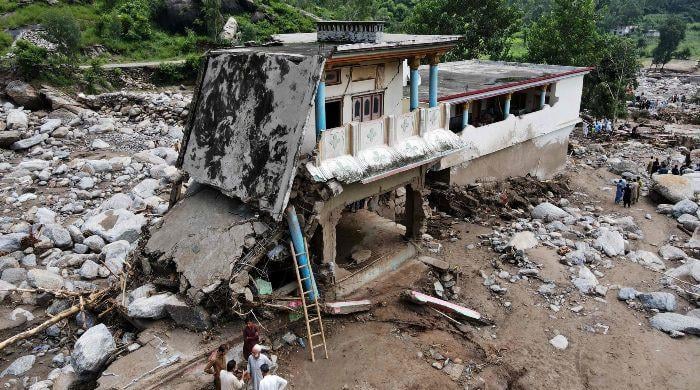Monsoon Floods Devastate Pakistan: Over 800 Dead Amid Climate Change and Mismanagement
Pakistan is grappling with devastating monsoon floods once more, with the number of fatalities exceeding 800 since late June. Half of these deaths occurred in August alone.
Authorities have issued warnings about potentially high flood levels in the River Ravi at Shahdara. The province of Punjab is at “exceptionally high” risk due to substantial rainfall and surplus water discharged from dams in Kashmir.
All major dams in the area have been opened, and alerts have been issued to Pakistan regarding potential downstream inundation.
More than 167,000 individuals in Punjab have been displaced from their residences, including approximately 40,000 who voluntarily evacuated following early warnings issued on August 14.
Villages in the north have been submerged, while major cities in the south, such as Karachi, face paralysis. Experts, officials, and residents concur that the extensive damage results from both natural elements and administrative shortcomings.
Climate Change Intensifies Monsoon Rains
Climate change has amplified the erratic and extreme nature of Pakistan’s monsoon rains.
Elevated global temperatures enable the atmosphere to retain increased moisture, leading to more intense downpours within shorter periods. In Buner, Khyber Pakhtunkhwa, over 150mm of rainfall occurred within a single hour, triggering sudden floods and landslides that demolished homes on mountain slopes.
The Pakistan Meteorological Department has cautioned that the intensity of monsoons will escalate in the coming decades, leaving limited scope for short-term remedies. In the northern regions, rising temperatures are also accelerating glacial melting, thereby elevating the likelihood of glacial lake outburst floods (GLOFs). Earlier in August, the Shisper Glacier surged into the Hassanabad nullah in Hunza, causing destruction to farmland and infrastructure.
Despite Pakistan accounting for less than one percent of global greenhouse gas emissions, it stands as one of the nations most susceptible to the climate crisis.
As a provincial legislator expressed, Pakistan is “paying a substantial price for international transgressions.”
Sherry Rehman, the former climate minister, echoed this concern, noting the global community’s sluggish response in providing meaningful assistance, even as Pakistan’s lives and livelihoods are repeatedly impacted by climate-related disasters.
The intensity of the 2025 floods has been exacerbated by cloudbursts — abrupt, localized downpours triggered by the rapid ascent and condensation of moist air.
These events overwhelm rivers and saturate the soil, leading to flash floods, mudslides, and devastating structural collapses.
Because heavy rainfall has obstructed access roads, even emergency teams equipped with ambulances and excavators have struggled to reach affected villages promptly.
Human Mismanagement Exacerbates the Crisis
Human mismanagement has amplified the consequences of natural hazards. Residential constructions persist along riverbeds, obstructing natural drainage patterns.
Regulations, such as the River Protection Act, which forbids construction within 200 feet of a river, are frequently disregarded.
In the Swat Valley, residents have seen their residences destroyed on multiple occasions, in 2010, 2022, and this year. Each time rebuilt too near the river.
Deforestation and extractive industries have also compromised natural defenses. Pakistan’s forest cover has dwindled to only 5%, the lowest in South Asia. Logging and mining activities in mountainous terrain have stripped slopes of protective vegetation. The loss of tree cover accelerates floodwaters down valleys with intensified force. Once dense forests slowed torrents; now, there are few obstacles in their path.
In urban areas, inadequate planning and clogged drainage systems have transformed rainfall into disaster. Karachi, a megacity with over 20 million residents, repeatedly experiences shutdowns following storms. Nullahs intended for stormwater drainage are obstructed by over 20,000 tonnes of solid waste generated daily, while unauthorized construction has narrowed or blocked drainage channels.
Informal settlements and upscale housing projects alike discharge sewage into these drains, compounding blockages. A report from the Human Rights Commission of Pakistan (HRCP) emphasized that floods in Karachi stem from “clogged drains, inadequate solid waste disposal, poor infrastructure, encroachments, elitist housing societies” as much as from rainfall.
Pakistan’s vulnerability is intensified by weak governance and inadequate preparedness.
Villagers in Swabi questioned the absence of early warnings prior to the floods and the delayed arrival of assistance.
The Pakistan Meteorological Department (PMD) acknowledges its limitations: while forecasting heavy rainfall is possible, predicting abrupt cloudbursts remains challenging, and communication gaps hinder timely alerts to rural communities. Although siren systems have been installed in some glacial valleys, comprehensive coverage is lacking.
At the urban level, governance failures are pervasive. Stormwater management in Karachi is fragmented among various overlapping authorities. Development projects face chronic underfunding or delays; opposition lawmakers recently alleged that the city spent only 10% of the allocated funds for a five-year flood resilience plan supported by international donors.
The city’s mayor conceded that he has repeatedly requested Islamabad to finance drainage upgrades, but the associated costs are so substantial that they could exhaust “the entire national budget.”
Pakistan’s struggle to adapt also reflects a question of priorities.
This year, the federal government reduced the Ministry of Climate Change’s budget to approximately $9.7 million while increasing defense spending to nearly $9 billion.
Critics contend that if Pakistan does not allocate resources to enhance its own resilience, international donors may be reluctant to provide assistance. While the government highlights IMF-linked allocations exceeding $2 billion for climate-related projects, experts point out that these often encompass existing dams or hydropower schemes rather than innovative adaptation measures.
The crisis is further complicated by the uncertain future of the Indus Waters Treaty (IWT), the 1960 agreement brokered by the World Bank to regulate river sharing between India and Pakistan.
India suspended its involvement in the pact last month, stating that it would keep it “in abeyance” until Pakistan disavowed cross-border militancy. Islamabad dismissed the action as unlawful, cautioning that any attempt to halt or divert Pakistan’s water share would be regarded as an “act of war.”
Analysts caution that with escalating climate-induced floods and droughts, the politicization of river flows could significantly undermine Pakistan’s food security.
Farmers’ representatives caution that erratic water supplies could reduce yields of wheat, rice, and sugarcane, escalate food prices, and push small-scale growers, already struggling with narrow margins, further into crisis.
In the meantime, over 1,000 development projects across sectors remain unfinished. Experts suggest that instead of relying exclusively on “top-down” projects, Pakistan should prioritize educating communities, promoting flood-resistant housing, and establishing a “poverty escape ladder” at the grassroots level. Without such initiatives, poverty will continue to be the most significant obstacle to resilience.
This year’s floods have resulted in deaths and displacement on a large scale, but are becoming increasingly commonplace. Pakistan’s geographic location makes it particularly vulnerable to the effects of climate change, yet decades of mismanagement, corruption, and neglect have transformed a natural hazard into a man-made disaster.
Unless deforestation is reversed, construction regulated, urban drains unclogged, and climate adaptation prioritized in policy and budgets, Pakistan faces the grim prospect of recurrent tragedy.



Comments (0)
No comments yet. Be the first to comment!
Leave a Comment